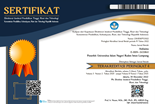Hubungan Gaya Hidup Hedonis Dengan Kecenderungan Impulsive Buying Pada Remaja
Abstract
Impulsive buying is an irrational purchase that occurs quickly without any consideration and there is no process of searching for information about the product purchased so that the purchase occurs because of an emotional impulsive. One of the factors that influence impulsive buying is a hedonic lifestyle. The hedonic lifestyle is a lifestyle or lifestyle that is expressed with activities, interests and opinions that prioritize emotional properties rather than logic and is a lifestyle that leads to pleasure which is the goal of life. This study aims to determine the relationship between hedonic lifestyle and impulsive buying in adolescents. This study uses a quantitative method with Pearson's product moment analysis. The subjects in this study were 360 adolescents aged 12-23 years in the city of Pekanbaru which were taken using quota sampling. Based on the results of research conducted that there is a positive relationship between the hedonic lifestyle and the impulsive buying tendency of teenagers in the city of Pekanbaru with a significance value of 0.000 and a correlation coefficient of 0.735, which means the higher the hedonic lifestyle, the higher the tendency of impulsive buying in adolescents, and conversely the lower the hedonic lifestyle. hedonic lifestyle, the lower the tendency of impulsive buying in adolescents in Pekanbaru. Thus, the hedonic lifestyle carried out by teenagers in Pekanbaru has a relationship with the tendency of impulsive buying.
Keywords: Impulsive Buying, Hedonic Lifestyle, Teenagers
Full Text:
PDFReferences
Alfaiz, M. A. (2018). Faktor Yang Mempengaruhi Impulsive Buying Konsumen Pands Yogyakarta dalam Perspektif Konsumsi Islami. Naskah Publikasi. Yogyakarta: Fakultas Ilmu Agama Islam Universitas Islam Indonesia.
Ancok, D. (2004). Psikologi Terapan: Mengupas Dinamika Kehidupan Umat Islam. (Cetakan Pertama). Yogyakarta: Darussalam Offset.
Aprilia, E. D., & Mahfudzi, R. (2020). Gaya Hidup Hedonisme dan Impulse Buying pada Mahasiswa. Jurnal Ecopsy. 7 (2).
Assael, H. (2004). Consumer Behavior. Edisi 6. United State of Amerika Thomson Learning.
Azwar, S. (2012). Reliabilitas dan Validitas. Yogyakarta: Pustaka Pelajar
Bashar, A., & Saraswat, K. K. (2014). Influence of Lifestyle and Cultural Factors on Consumer Impulse Buying Behaviour. International Journal of Marketing & Financial Management. 2 (1).
Bashir, S., Zeeshan, M., Sabbar, S. (2013). Impact of Cultural Values and Life Style on Impulse Buying Behavior: A Case Study of Pakistan. International Review of Management and Business Research. 2 (1).
Ekowati, T. (2009). Compulsive Buying: Tinjauan Pemasar dan Psikolog. Segmen Jurnal Manajemen dan Bisnis. (8).
Fitriyani, N., Widodo, P. B., Fauziah, N. (2013). Hubungan Antara Konformitas dengan Perilaku Konsumtif pada Mahasiswa di Genuk Indah Semarang. Jurnal Psikologi Undip. 12 (1).
Gushevinalti. (2010). Telaah Kritis Perspektif Jean Baudrilard pada Perilaku Hedonisme Remaja. Jurnal Ilmiah Idea. 4 (15).
Herabadi, A. G., Knippenberg, A., Verplanken, B. (2019). Consumption Experience of Impulse Buying in Indonesia: Emotional Arousal and Hedonistic Considerations. Asian Journal of Social Psychology.
Kelly, E. (2015). Gaya Hidup Hedonis dan Impulse Buying pada Kalangan Remaja Putri. Jurnal Sketsa Bisnis. 2 (1).
Kharis, I. F. (2011). Studi Mengenai Impulse Buying dalam Penjualan Online (Studi Kasus di Lingkungan Universitas Diponegoro Semarang). Skripsi. Semarang: Fakultas Ekonomi Universitas Diponegoro.
Kotler, P., & Armstrong, G. (2008). Principles of Marketing: 12th edition. New Jersey: Pearson.
Kusuma, Y. R. (2014). Pengaruh Brand Experience Terhadap Brand Loyalty Melalui Brand Satisfaction dan Brand Trust Harley Davidson di Surabaya. Jurnal Manajemen Pemasaran Petra. 2 (1), 1-11.
Lestari, E. S., Silviandari, I. A., Widyasari, S. D. (2012). Hubungan Antara Gaya Hidup Hedonis dengan Kecenderungan Impulse Buying Produk Pakaian Imitasi pada Pria Homoseksual di Malang Raya. Academia Accelerating the World’s Research.
Lumintang, F. F. (2010). Pengaruh Hedonic Motives Terhadap Impulse Buying Melalui Browsing dan Shopping Lifestyle pada Online Shop.
Mahdani, I., Syahputra, A., Yunus, M. (2017). Pengaruh Gaya Hidup Hedonisme, Materialisme dan Pendapatan Terhadap Shopping Lifestyle Serta Dampaknya pada Pembelian Impulsif Online Produk Fashion pada Masyarakat Kota Banda Aceh. Jurnal Manajemen dan Inovasi. 8 (3), 65- 75.
Mangkunegara, A. (2005). Perilaku Konsumen. Bandung: Refika Aditama.
Masmuadi, M., & Rachmawati, M.A. (2007). Hubungan Antara Konsep Diri dengan Kecenderungan Gaya Hidup Hedonis pada Remaja. Jurnal Psikologi. Yogyakarta: Fakultas Psikologi Universitas Islam Indonesia.
Nadzir, M., & Ingarianti, T. M. (2015). Psychological Meaning of Money dengan Gaya Hidup Hedonis Remaja di Kota Malang. Seminar Psikologi & Kemanusiaan.
Rook, D. W. (1987). The Buying Impulse. The Journal of Consumer Research. 14 (2), 189-199.
Rook, D. W., & Fisher, R. J. (1995). Normative Influences on Impulsive Buying Behavior. Journal of Consumer Research. 22, 305-313.
Santrock, J. W. (2007). Perkembangan Anak. Jakarta: Erlangga.
Saputra, T.R. (2017). Hubungan Antara Gaya Hidup Hedonisme dengan Kecenderungan Impulse Buying Terhadap Trend Fashion pada Remaja Kota. Skripsi. Surabaya: Fakultas Psikologi dan Kesehatan Universitas Islam Negeri Sunan Ampel.
Sari, R. K. (2016). Kecenderungan Perilaku Compulsive Buying pada Masa Remaja Akhir di Samarinda. Psikoborneo. 4 (1), 1-9.
Septila, R., & Aprilia, E. D. (2017). Impulse Buying pada Mahasiswa di Banda Aceh. Psikoislamedia Jurnal Psikologi. 2 (2).
Setianingtyas, B. L. (2021). Hubungan antara Gaya Hidup Hedonisme dengan Impulse Buying Online Saat Covid-19 pada Dewasa Awal. Skripsi. Malang: Fakultas Psikologi Universitas MuhammadiyahSilvera, D. H., Kropp, F., Lavack, A. M. (2014). Impulse Buying: The Role of Affect, Social Influence, and Subjective Well-Being. Journal of Consumer Marketing.
Solomon, M. R.(2009). Consumer Behavior: Buying, Having, and Being. Eight Edition. New Jersey: Pearson Education.
Solomon, M. R., & Rabolt, N. (2009). Consumer Behavior in Fashion: Second edition. Prentice Hall: Pearson.
Sugiyono. (2015). Statistika Untuk Penelitian. Bandung: Alfabeta
Sugiyono. (2016). Metode Penelitian Pendidikan (Pendekatan Kuantitatif, Kualitatif, dan R & D). Bandung: Alfabeta
Sugiyono. (2017). Metode Penelitian Kuantitatif. Bandung: Alfabeta
Susianto, H. (1993). Studi Gaya Hidup Sebagai Upaya Mengenali Kebutuhan Anak Muda. Jurnal Psikologi dan Masyarakat. Jakarta: PT Gramedia.
Takariani, C. S. D. (2013). Pengaruh Sinetron Remaja di Televisi Swasta Terhadap Sikap Mengenai Gaya Hidup Hedonis. Jurnal Penelitian Komunikasi. 16 (1).
Utami, C. W. (2006). Manajemen Ritel: Strategi dan Implementasi Ritel Modern.
Jakarta: Salemba Empat.
Verplanken, B., & Herabadi, A. (2001). Individual Differences in Impulse Buying Tendency: Feeling and No Thinking. European Journal of Personality. 15, 71-83.
DOI: http://dx.doi.org/10.24042/ajp.v5i1.14018
Refbacks
- There are currently no refbacks.
Copyright (c) 2022 ANFUSINA: Journal of Psychology











